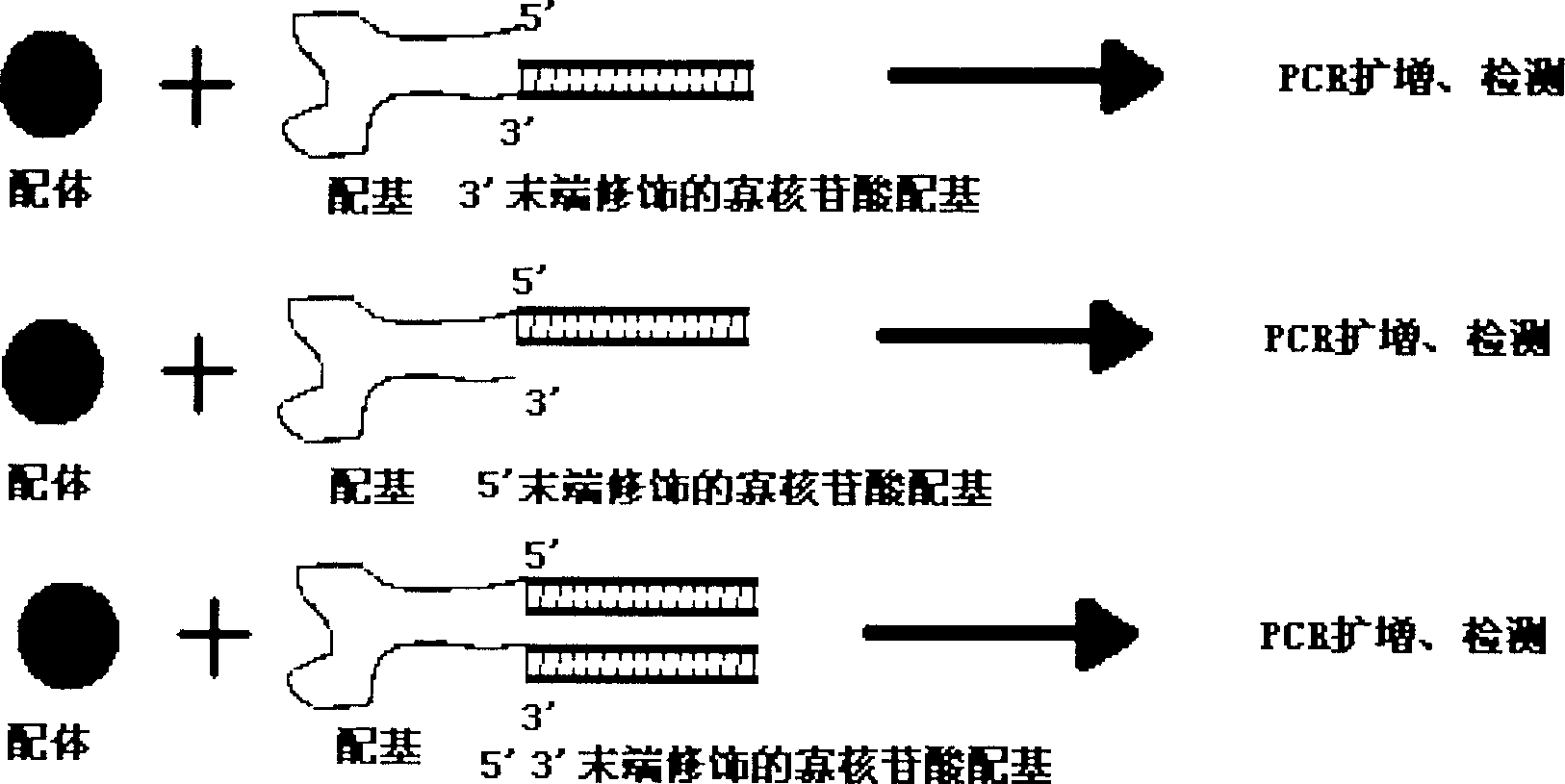Antigen and ligand PCR pipe detecting reagent case, its manufacturing method and application
A technology for detection kits and detection reagents, which is applied in the direction of measuring devices, instruments, scientific instruments, etc., can solve the problems of inability to quantify, primers that cannot solve the problem of impurity, primer dimer amplification, etc., and achieve high sensitivity and mechanized synthesis The effect of high precision and large amount of stored information
- Summary
- Abstract
- Description
- Claims
- Application Information
AI Technical Summary
Problems solved by technology
Method used
Image
Examples
Embodiment 1
[0106] Example 1: Novel Immuno-PCR Detection
[0107] refer to figure 2 , is a new PCR detection process. After the PCR tube is treated, it is coated with an antibody, and incubated with the test sample to form an antibody-antigen complex; after washing, add a ligand-labeled detection antibody, and after incubation, wash Remove unbound detection antibodies, PCR amplification for ligand modification sequences, analysis and processing of amplified products. The specific steps are as follows:
[0108] 1. Preparation of detection PCR tube: Treat the PCR tube with 3.5% glutaraldehyde at 37° C. for 2 hours, wash it three times with three-distilled water, and coat the monoclonal antibody (or capture ligand, see Example for coating method) to capture hepatitis B core antigen Two, 1), block with 5% skimmed milk powder (or bovine serum albumin, etc.), 50 ul of 1.0 mol pH9.6 sodium bicarbonate buffer, and dry for use.
[0109] 2, the preparation of detection antibody reagent: will de...
Embodiment 2
[0118] See for reference image 3 , Ligand detection; After the PCR tube is treated, the ligand that is coated with the recognition ligand is incubated with the detection sample to form a ligand-ligand complex; after cleaning, the recognition and detection ligand labeled with the modified sequence is added After co-incubating with different ligands, the unbound detection ligands are washed away, and the PCR amplification of the ligand modification sequence, the analysis and processing of the amplified products. The specific steps are as follows:
[0119] 1. Preparation of PCR tubes: Treat PCR tubes with 3.5% glutaraldehyde at 37° C. for 2 hours, wash three times with three-distilled water, and coat streptavidin; use 5% skimmed milk powder (or bovine serum albumin and poly( dI.dC), etc.), PH9.6 sodium bicarbonate buffer was treated at 37 ° C for 2 hours to block, and 1ml 1.0mol pH9.6 sodium bicarbonate buffer was rinsed three times for three minutes each time; the captured mou...
Embodiment 3
[0129] refer to Figure 5 , real-time quantitative-PCR simultaneously detects four ligands
[0130] 1. Preparation of detection PCR tube: Treat the PCR tube with 3.5% glutaraldehyde at 37°C for 3 hours, wash it three times with steamed water, and coat it with streptavidin; use 5% skimmed milk powder (or bovine serum albumin and poly (dI.dC) etc.), PH9.6 sodium bicarbonate buffer was treated at 37°C for 2 hours to block, rinsed three times with 1ml1.0mol pH9.6 sodium bicarbonate buffer for three minutes each time; the four captured The ligand of the ligand, concentration: 25pmol, namely:
[0131] 1) peptide from HIV-1 Rev,
[0132] Biotin-5'-
[0133] GCUUGGUACCGAGCUCGGAUCCACGUAGUAACGGGCCGCCAGU
[0134] GUGCUGGAAUUCGGGUCGUUCUUG-3;
[0135] 2) NS3 protease protein,
[0136] Biotin-5'-
[0137] GGGAACUCGAUGAAGCGAAUUCUGUGUAUCCUGUACGCAAG
[0138] UACUAGCCAUACAGGCCUAUCUAUCGGAUCCACG-3';
[0139] 3) TAR RNA element of HIV-1,
[0140] Biotin-5'-
[0141] CCCGAGCCAGCAUAGCUACG...
PUM
 Login to View More
Login to View More Abstract
Description
Claims
Application Information
 Login to View More
Login to View More - R&D
- Intellectual Property
- Life Sciences
- Materials
- Tech Scout
- Unparalleled Data Quality
- Higher Quality Content
- 60% Fewer Hallucinations
Browse by: Latest US Patents, China's latest patents, Technical Efficacy Thesaurus, Application Domain, Technology Topic, Popular Technical Reports.
© 2025 PatSnap. All rights reserved.Legal|Privacy policy|Modern Slavery Act Transparency Statement|Sitemap|About US| Contact US: help@patsnap.com



